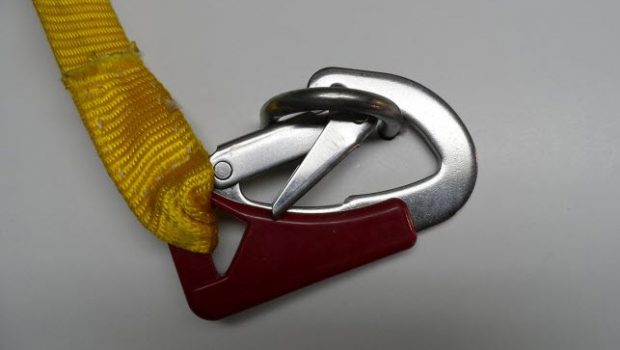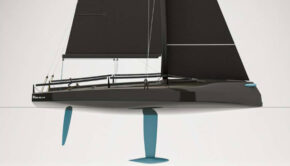Safety Tether Clip-in Caution
Published on March 14th, 2018
Practical Sailor has been testing sailboats and marine equipment for over 40 years, and their business model which is solely based on reader subscription, keeps their hands clean of commercial bias. This PS report focuses on whether safety equipment is actually safe.
Since late last year, Practical Sailor has been testing various sailing safety tether clips and snap hooks to determine what could have contributed to the death of a Simon Speirs, who fell overboard during the Clipper Ventures Round the World Race late last year. The tragic incident was unusual because, according to all reports, Mr. Speirs was wearing a safety harness and tether that was connected to a jackline at the time of the accident.
We’ve posted two previous blogs on this topic, the first, posted several weeks after the accident and the second posted and updated more recently. The March 2018 issue of Practical Sailor magazine report “Safety Tethers Under Scrutiny,” featured a more detailed report of our initial findings.
The focus of the March 2018 report was primarily on hooks attached to jacklines and the actual strength of the various tether snap hooks on the market. In that report, our tester Drew Frye demonstrated that, under certain circumstances, some snap hooks can bend and open under loads of less than 350 pounds while connected to a jackline.
Recently, Frye made a similar startling discovery, this time with regards to hard clip-in points such as padeyes and u-bolts, which are commonly used in lieu of jacklines in working stations such as the cockpit.
Based on our testing, a variety of locking clips that are certified as meeting the ISO 12401 Standard for racing sailing tethers, World Sailing Small craft — Deck safety harness and safety line — Safety requirements and test methods, do not appear to comply with the portion of the standard (quoted below) that is used to establish that the hook cannot easily release from a fixed attachment point by accident.
5.4 Accidental hook opening testing
5.4.1 The tendency of the hook to accidentally become detached from its attachment point shall be tested using the following three styles of attachment point, made from 8 mm diameter rod:
a) a straight rod;
b) an eye bolt of internal radius 10 mm;
c) U-bolts of internal radius 15 mm and 20 mm.
5.4.2 Move the hook by hand as far as is possible in the following directions with the attachment point mounted vertically:
a) move forward and backward, right and left without any rotation, movement being in the horizontal plane;
b) rotate in the horizontal plane by up to 360° using the attachment point as the axis, rotating both clockwise and anticlockwise;
c) rotate in the vertical plane by up to 360° about the axis of the hook, rotating both clockwise and anticlockwise;
d) rotate in the vertical plane by up to 360° about an axis running through the attachment point, rotating both clockwise and anticlockwise.
Tether Snap Hook Videos
To illustrate how a tether snap hook certified to the IS0 12401 Standard might accidentally open under relatively light loads, we’ve posted two videos below. We’ve sent these videos to US Sailing safety authorities, tether manufacturers, and the Marine Accident Investigation Branch in Great Britain, which published a safety bulletin on safety tethers after our reports first appeared. We are hoping that one of these entities will work with an official ISO testing facility to review the standard.
The first video (above) is a demonstration of how the tether snap hook subjected to less than 30 pounds of pressure can behave when clipped to a u-bolt that meets the specifications indicated by ISO 12401. Based on our understanding of the intention of the standard, it appears that the tether clip (based on the Gibb design) does not meet the ISO standard accidental opening test, quoted above.
However, because the standard does not specify applying any load or clearly indicate the direction of pull to test the hook’s security, this is open for debate. Several tethers currently being sold and bearing the ISO 12401 imprimatur use this type of clip, variations of which have been in use by sailors for more than three decades. The ambiguities in the ISO 12401 standard is one of the reasons we are advocating that the standard be revised.
The second video (above) is a re-enactment of what might possibly have happened in Mr. Speirs’ accident. This simulation is similar to the scenario described in the MAIB investigation and explored in the PS March 2018 issue, except in this case the interfering cleat (a metal tube in our test) puts pressure on the gate, not the side of the hook.
Once the gate is breached at about 30 pounds of load, the nose hooks the tether and then begins opening, reaching nearly a full extension and letting go of the tether at about 350 pounds of load. Loading a nose-hooked snap hook was the easiest way for our testers to duplicate the bend described in Mr. Speirs’ tether snap hook, which was recovered after the accident. This test is similar to one that has long been required of certified via ferrata climbing tether carabiners.
Our tester found that most safety clips and snap hooks used by sailors today are vulnerable to unhooking if twisted or pushed in the wrong direction (from top left to bottom right), or wedged between something else and the clip-in point. All clips are weaker at the gate, and every effort should be made to clip with the spine inside the u-bolt (gate facing up) so that the gate is not pressed against any solid object.
Cross Loading
The 2017 Clipper accident involving the loss of Simon Speirs is presumed to have resulted from a snap hook becoming trapped under a deck cleat and then loaded sideways. While there are stronger carabiners available (see PS March 2018), side-loading or cross-loading on the gate or spine is always forbidden by the manufacturer for good reason. The hooks are not designed to a take side or gate loads and this practice can weaken the carabiner and damage the gate over time. The effect of these types of eccentric loads are also more difficult to predict.
With the exception of and screw-locking carabiners and the ISC SH 903 carabiner, a triple-action climbing carabiner featured in the March 2018 issue, testers were able to devise a combination of twists and bumps that could dislodge every sailing tether hook in our comparison with less than 30 pounds of force. To some extent, the user can prevent many of these problems through prudent use and by attaching the carabiner in the optimum orientation. But our results show that these locking clips are vulnerable to accidental opening and we must strive to create hard points that are mistake-proof.
• No cross loading or gate impingement should be possible though a range of rotation. Imagine the full arc the carabiner can move through and every way the sailor is likely to clip it. This may be best achieved by clipping in a specific way. For example, u-bolts should be clipped with spine against the deck and aluminum toerails –though generally poor clip in points– should also be clipped from underneath if used.
• U-bolts and padeye openings should be round in shape and allow easy rotation and flipping of carabiners. With the UIAA type K and similar carabiners (see previous blog posts), this requires the opening be at least 15/16-inch wide and ¾-inch tall. Rectangular padeyes should be avoided because they restrict smooth rotation. Many folding padeyes, though strong enough, are too small.
• Folding padeyes should be reserved for the cockpit floor or seats. They are strongest when the load is perpendicular to the hinge and they are partially folded away from the side with two fasteners (this is the opposite from the preferred direction of pull when using fixed padeyes and u-bolts, which are stronger when the force is aligned with the U).
• All other locations should use fixed hard points to facilitate one-handed clipping.
• Bolt hangers can create strong anchor points where a well-reinforced 3/8-inch bolt is already available (see “Ocean Tested: Rock Climbing Gear” – PS September 2012).
• Sole use. U-bolts and other hard points cannot be used for other rigging if that use creates a cross load or impingement. It is very tempting to use a fitting for multiple purposes, but this prevents the carabiner from rotating freely. Instead attach a small loop of line (5 mm Dyneema spliced into a loop) or a pre-fabricated Dyneema rock climbing sling. Do not use nylon—the UV resistance is inferior. A u-bolt should not be shared by two snap hooks or clips whenever possible.
Before making any purchases or modifications to your existing tether-jackline arrangement, we recommended that you read the two previous blog posts on this topic mentioned above.
For a more detailed report on fixed clip-in points and tips on how you can ensure that your tether snap hook can not self-release in an emergency, see the April 2018 issue of Practical Sailor. For an in-depth look at the gear and seamanship skills that can keep you connected to your boat, you can’t find a better resource than our ebook Man Overboard Prevention and Recovery. It is available at our online bookstore.








 We’ll keep your information safe.
We’ll keep your information safe.